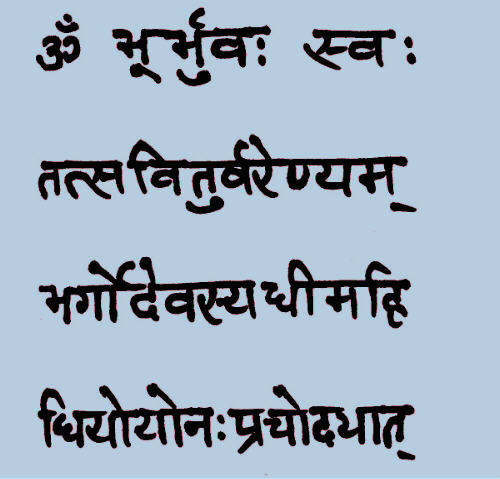|
|
Gayatri Mantra Gayatri Mantra (GUY-ah-tree) is one of the most known and beneficial of the ancient Sanskrit mantras. Gayatri is a mantra of physical, emotional, and mental healing, purifying the subtle karmas, protection from the onslaught of obstacles, and of spiritual awakening or Self-realization.
Aum Bhur Bhuva Svah On the absolute reality and its planes, Audio Podcast:
------------------------------ AUM/OM: Absolute reality. That which encompasses the three states of waking, dreaming, deep sleep, represented by AUM, the three levels of gross, subtle, causal, the three levels of conscious, unconscious, subconscious, and the three universal processes of coming, being, and going. Absolute silence beyond the three levels is the silence after AUM. Bhur: Physical realm or plane; earth. Bhuva: The subtle or astral plane. Svah: The higher, celestial plane. ------------------------------ Tat: That, the essential essence. Savitur: Bright, luminous, sun-like, inner power of spiritual light, which brings one to Self-realization. Varenyam: Finest, best, choicest, fit to be sought. ------------------------------ Bhargo: Destroyer of obstacles. Effulgence Devasya: Divine, resplendent, shining Dhimahi: We meditate. ------------------------------ Dhiyo: Our being of intelligence, intellect, understanding, mind/heart Yo: Who, which Naha: Our Prachodayat: May enlighten, direct, inspire, guide, impel. ------------------------------ 40 day practice The period of 40
days has been widely recognized as an auspicious period both in
the East and the West since ancient times. A traditional way to do
an extended mantra practice is to choose a number of repetitions
per day
Listening to this online Gayatri mantra recording of 108 repetitions (18 minutes) is equivalent to one round of a mala. A mala is a set of counting beads with 108 beads. Only 100 are counted, with the other 8 considered an offering to the divine, however you personally hold that. You might choose to do 1, 2, 3, or 4 rounds of 108 mantras per day, counting with a set of mala beads. Or, you can use the Gayatri Mantra CD instead of the mala beads, as the CD has 4 tracks of 108 repetitions each. You might choose to do 1, 2, 3, or 4 tracks of 108 mantras per day. You might also want to alternate between doing some with the recording and some without, counting instead with a set of mala beads. It has been said that there is freedom in discipline; choosing to do a regular practice frees the mind from wondering what practice will be done that day. It is also important not to do the mantra practice with rote repetition, but rather, with feeling and awareness. By running your own experiment for 40 days, you can decide for yourself whether or not the practice is beneficial. Extended practice A noticeable level of mantra siddhi (power of the mantra) is said to come with 125,000 repetitions of a mantra (Such an extended practice is called a purascharna). This is equivalent to 1250 rounds of a mala. Listening to this online Gayatri mantra recording of 108 repetitions (18 minutes) is equivalent to one round of a mala (Or, you can also use the Gayatri Mantra CD). To complete the equivalent of 1250 rounds of a mala, or a total of 125,000 repetitions of Gayatri mantra, will take this amount of time:
Such an extended practice with Gayatri mantra can have a tremendous effect in stabilizing the mind in preparation for advancing in meditation. Such a practice simply must be done personally to understand the benefits. It does take quite a commitment to do this practice every day for such a long period, but it is well worth the effort. In choosing the level of practice per day, it is important to have stability from one day to the next, and to not skip any days. It is best to choose the level that works for you consistently, rather than changing the number from day to day. For example, if two rounds per day is a good number (34 minutes), then it's better to stay with that amount each and every day, not to do none on one day, but four on the next day.
-------
|
|
||||||||||||||||||||||||||||||||||||||||||||||||||


